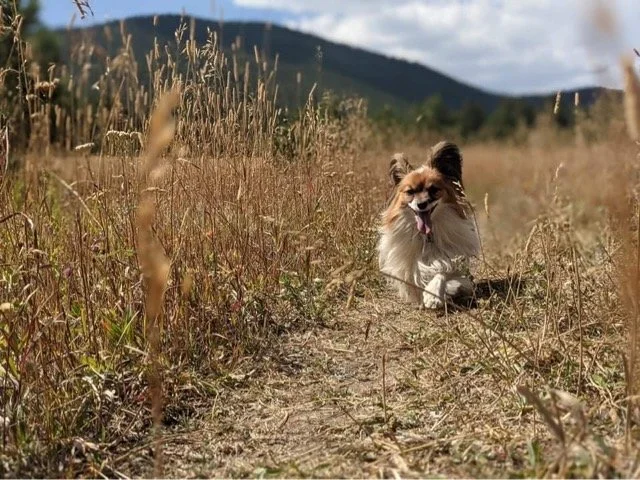Let’s talk about rattlesnake avoidance training for our dogs!
As spring quickly approaches, we are all excited to once again begin our summer outdoor adventures with our dog! Hiking, paddle boarding, trail running– so many adventures await! However, this change in season also marks the start of snake season. As the ground thaws and the temperature rises, rattlesnakes will be coming back to trails, fields, and parking lots to soak up the sun and hunt for prey. As dog guardians and outdoor enthusiasts, we want to keep our dog safe and respect animals in their environment. To do this, we can train our dog to avoid all snakes, significantly decreasing the chances of a venomous snake bite.
To train our dog to avoid snakes, there are two main components: a rock-solid recall and teaching a snake alert. A snake alert is a behavior you teach your dog to perform when they perceive a snake in their environment. The snake itself becomes the cue for the behavior. However, the alert won’t be strong enough if the dog doesn't also have a secure recall. Coming back to you has to have a strong reinforcement history, or else the alert won’t be reliable. A snake alert is a behavior chain, outlined below.
Dog perceives snake in the environment, through sight, scent, or sound.
Dog visually locates handler.
Dog runs to handler enthusiastically.
Dog performs their snake alert when they get to handler.
Handler marks and rewards.
Team is able to move away from the snake safely.
In this article, we will focus on teaching your snake alert. You can click here to read our recent blog post, Building Blocks for an Off-Leash Recall!, to learn more about teaching your dog a rock-solid recall.
To teach your dog a snake alert, we start by teaching the behavior itself. Essentially any behavior can be a snake alert, but ideally you want it to be something that your dog isn’t likely to perform without being prompted, such as a hand-touch or leg-touch. If your dog doesn’t jump, a jump-up cue could work well, while if your dog is a frequent jumper that wouldn’t be a good match. Once you’ve settled on a behavior, teach the behavior to your dog and generalize it to many different environments and contexts. Before we transfer the cue over to the snake, we want to be sure that the alert is fluent.
Teaching a Hand-Touch:
Present your hand to your dog
Mark & reward for any engagement with the hand presented
In between repetitions, hide your hand behind your back and then bring it out again - this maintains the novelty
Gradually increase criteria until you are only mark and reward when your dog touches your hand with their nose
Watch the video below on teaching a hand touch!
Once your dog’s alert behavior is fluent and can be performed under a variety of circumstances, it’s time to transfer your cue over to the snake. We do this by isolating the components of sight, scent and sound of the snake cue, and asking our dogs to do their alert behavior when they perceive any or all parts of the snake’s presence in the environment.
This is just a brief overview of how we teach rattlesnake avoidance training at Summit Dog Training! If you are interested in learning more and taking your dog’s rattlesnake avoidance behavior to the next level, consider joining our virtual and in-person training options, where instructor Amy Creaven provides in-depth, expert knowledge and guidance. We are offering in-person and online practice sessions, both are available a la carte or as packages with our new online course! If you are an outdoor adventure enthusiast and want to protect your dog from venomous snakes, this course is for you!
Summit Dog Training offers group dog training classes & private lessons in Fort Collins, Colorado, as well as online self-study courses & online private lessons for education on how to live the best life with your dog! If you are looking for more training support, please don’t hesitate to contact us! We’d love to help you and your dog get ready for any adventure.

